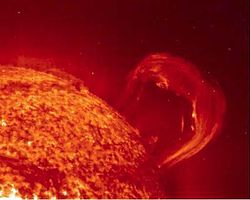Coronal cloud
| Coronal Cloud | |
|---|---|

An image of a coronal mass ejection, with the coronal cloud visible around it.
|
|
| Overview | |
| Name: | Coronal Cloud |
| Type: | Flare |
| Area: | Chromosphere |
| Statistics | |
| Average Size: | 66,000-240,000 Km |
| Temperature: | Same as Solar Flare |
| Occurrence Ratio: | About 4 Times Per Day |
| See also, CME | |
A coronal cloud is the cloud of hot plasma gas surrounding a coronal mass ejection. It is usually made up of protons and electrons. When a coronal mass ejection occurs, it is the coronal cloud that usually reaches Earth and causes damage to electrical equipment and space satellites, not the ejection or flare itself. The damage is mostly the result of the high amount of electricity moving through the atmosphere.
A coronal cloud is released when a solar flare becomes a coronal mass ejection; the coronal cloud often contains more radioactive particles than the mass ejection itself. A coronal mass ejection occurs when a solar flare becomes so hot that it snaps and breaks in two, becoming a "rope" of heat and magnetism that stretches between two sunspots. The resulting coronal mass ejection can be compared to a horseshoe magnet, the sunspots being the poles and the oscillating magnetic connector the handle. Coronal mass ejections typically do not last very long, because they cool down as the coronal cloud of gas is released and begins to hurtle away from the sun.
When a coronal cloud occurs, it can take several days for the plasma to grow cool enough to detach from the sun. This usually happens before the coronal mass ejection is able to cool enough for the magnetism to dissipate, at which point the solar flare cycle begins again. While the gas cloud is still cool enough to be in a semi-liquid plasma state, it clings tightly to the mass ejection, insulating it from the cold temperature of extra-solar space.
As the outer edges of the cloud begin to cool, the mass ejection's magnetic rope begins to cool, thereby decentralizing what remains of the flare by weakening its magnetic pull. After the cloud begins to cool, it gradually cools further and further into its core. The mass ejection expands into space as its insulating cloud weakens, weakening the magnet even more. By this point, the sun spots are all but gone.
When the coronal cloud changes completely from gas to liquid, the cycle of detachment begins. The inner, liquid plasma area of the cloud is relatively small and being heated by the mass ejection, not the other way around. The mass ejection loses its magnetism almost immediately, and cools to gas form or falls back into the sun within hours. However, the coronal cloud is still attached to it.
...
Wikipedia
